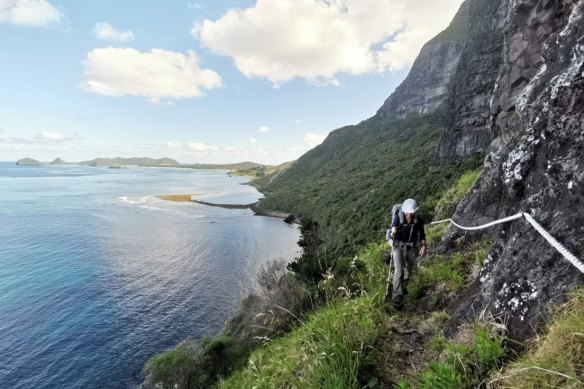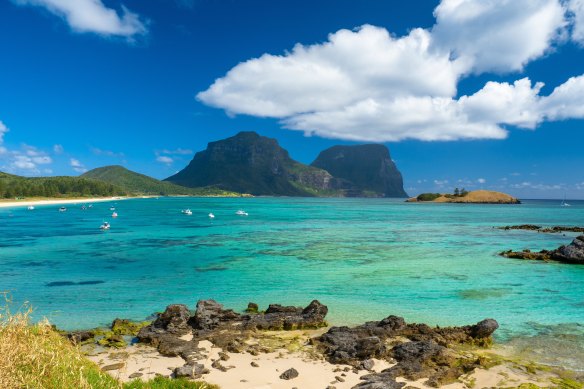This was published 2 years ago
How Australia rescued an island plagued by more than 200,000 rats
By Laura Chung
Animals pushed to the brink of extinction by rats have been brought back to life on Lord Howe Island, with some bird populations doubling in number within 12 months of the extermination of the last of the invasive pests.
The island was once plagued by thousands of rodents, which called the World Heritage-listed location home since about 1918. At one stage, it was estimated there were more than 210,000 rats running amok on the island. House mice are thought to have come to the island as early as 1860 and added to the ecological difficulties.

The wildlife on Lord Howe island is booming after feral animals were removed.Credit: NSW Government
Feral cats, goats and pigs also destroyed the island’s natural habitat, but management controls implemented in about 1979 tackled these larger species. While this helped bolster native populations, the rats still caused significant damage.
It wasn’t until 2019 that a rat eradication program began.
With no invasive species on the island, its ecosystem is thriving. Among the animals bouncing back is one of Australia’s rarest birds, the Lord Howe Island Woodhen, whose population has increased five-fold in four years, and more than doubled in the past 12 months.
Minister for Environment James Griffin said a recent survey found the endangered bird had boomed to 1147, compared to about 209 in 2019 before the control of the rats had started. In the 1970s, there were only 30 Woodhens on the island.
“The NSW government’s rodent control program is a world first for a permanently inhabited island, and the results for the biodiversity on Lord Howe are remarkable,” he said.
Others success stories include the Lord Howe wood-feeding cockroach, which was presumed extinct on the island for at least 80 years, but has been rediscovered. Four critically endangered snails that were thought to be extinct have also been found.
Ongoing monitoring on the island continues, including by bringing in rat detection dogs every few months to ensure the unwanted pests are gone. The last rat spotted was in August last year.
Globally eradication programs of invasive species on islands have become a key tool against the extinction crisis.

There were once only 30 Lord Howe Woodhen, one of Australia’s rarest birds, on the island. Today, there are more than 1000. Credit: NSW government
The Database of Island Invasive Species Eradications has tracked 2000 programs between 1950 and 2019 and shows that the programs have had an 88 per cent success rate on more than 800 islands.
But Lord Howe Island offers the first rodent control program to be conducted on a permanently inhabited island.
It’s just one of many feral animal programs that the NSW government is delivering. But it’s no small challenge. There are billions of feral animals in Australia, and among the worst offenders are rabbits, cane toads, cats and carp.
Factors like back-to-back natural disasters and climate change are only increasing feral animal populations. While invasive species flourish in warmer, cooler, wetter or drier surroundings, some native species are struggling to adapt to shifting weather patterns.
Even as it recovers from pest invasion though, Lord Howe Island is suffering from a changing climate.
Island temperatures have increased by 0.8 degrees since 1950 and rainfall has declined 32mm since 1970.
Naturalist and Lord Howe Island Museum curator Ian Hutton said in the 40 years he’s lived on the island, he’s noticed the cloud layer at the top of the mountains starting to thin, which is harmful to a delicate, threatened moss.
Fishermen on the island are now catching more subtropical fish - an indication waters off the island are warming, and parts of the lagoon bleached severely in 2019 for the first time.
“We had big issues on the island with feral animals, but we’ve taken the threat off. Climate change is a big one we have to tackle next,” he said.

Lord Howe Island had the first rodent control program to be conducted on a permanently inhabited island.
What is often more straightforward is tackling other stresses on native species, such as better management of invasive species or habitat destruction, said Queensland University of Technology conservation ecologist Dr Justine Shaw.
“If you gave me $20 million to make an island resilient to climate change I might throw it at watering systems or species breeding programs - there is much more uncertainty and complexity with climate change how species are affected. But with clear management objectives such as getting rid of invasive species, that’s a tangible thing to do. We are confident native animals’ chances of survival are likely,” she said.
“Islands have unique biodiversity, they have unique species that don’t occur elsewhere.”
“We can’t remove every threat to species on islands, but studies show that invasive species pose one of the biggest threats to native species, removing them guarantees success.”
A guide to the environment, what’s happening to it, what’s being done about it and what it means for the future. Sign up to our fortnightly Environment newsletter here.